In April, 2015, a massive earthquake in Nepal killed nearly 9,000 people and injured up to 22,000. The worst damage occurred in Gorkha, an area located in the foothills of the Himalayas, about halfway between Kathmandu and Pokhara. Within minutes, entire villages crumbled to the ground. Roads and other infrastructure were so damaged that rescue efforts were hampered for weeks, adding to the loss of life. Though the earthquake was not felt as severely in the country’s two largest cities, structures in Kathmandu suffered significant damage because the city was built upon the soft soils of an ancient dry lake bed. Some of the worst damage occurred at the seven ancient UNESCO World Heritage sites that are scattered around the Kathmandu Valley.
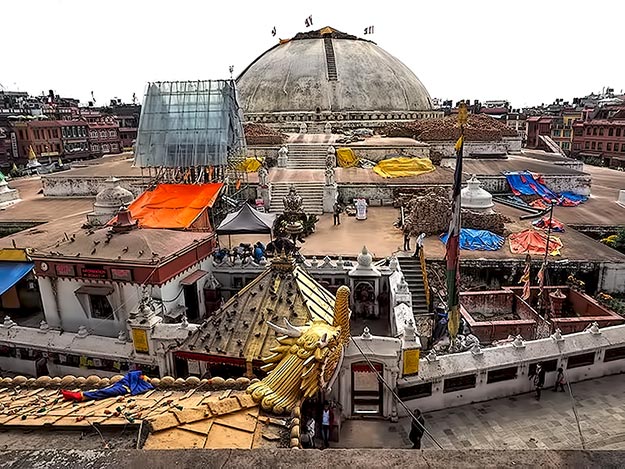
My first view of the damage to these UNESCO sites was in November of 2015, approximately six months after the quake. I stood in front of Boudhanath Stupa, the most important Buddhist site in the country. It’s immense white dome, which had always sparkled under the sun like freshly fallen snow, was ashen gray and streaked with dirt. The golden pinnacle and its famous all-seeing eyes, which had crowned the dome, was entirely gone. Boudhanath had always been my favorite temple in Kathmandu and I was overwhelmed with sorrow as I surveyed the destruction. I wept unashamedly.
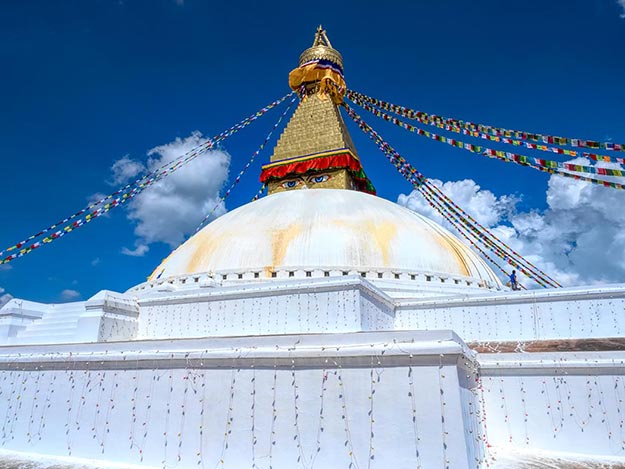
I returned to Nepal last November, two and a half years after the earthquake. I’d heard that very little progress had been made toward the temple restorations in Nepal and wasn’t sure what to expect. Anxiously, I climbed out of the taxi at Boudhanath Stupa. At the entrance I stopped in my tracks. The golden spire and all-seeing eyes once again topped the stupa, and workers were splashing the brilliant white dome with arcs of glimmering gold-leaf paint. Once again I dissolved in tears, though this time they were tears of joy. Shop owners and monks from the surrounding monasteries told me that the work had been overseen by the monastic community and funded by donations. I myself had made a small donation during my previous visit, and it warmed my heart that the corruption which plagues Nepal had not been a factor at Boudhanath.
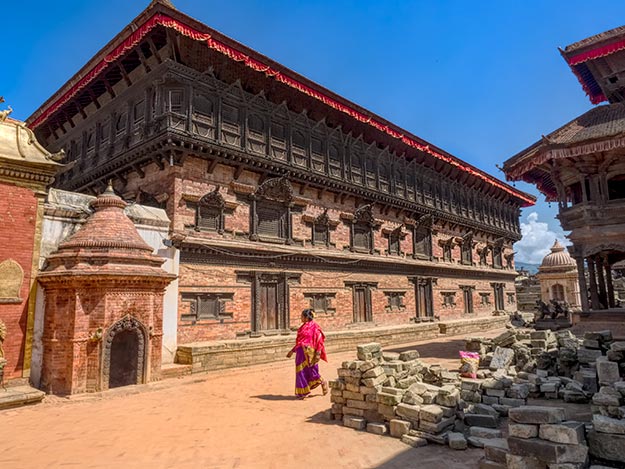
Encouraged by what I saw at Boudhanath, I turned my attention to the Durbar Squares in and around the city. Somewhat confusingly, there are three Durbar Squares (Palace Squares) in the Kathmandu Valley, all of which have been awarded UNESCO World Heritage status. The first, technically known as Basantapur Durbar Square, is located in the center of the city of Kathmandu. Across the river, a second Durbar Square is found in Patan. Once a separate kingdom with a king of its own, today Patan is part of the greater metropolitan area of Kathmandu. The final palace square is in the town of Bhaktapur, located about 10 miles away from the capital. All three of these sites sustained significant damage, and during my earlier visit precious little progress had been made toward their restoration. Most of the sites still lay in ruins, surrounded by heaps of rubble (read more about that here).
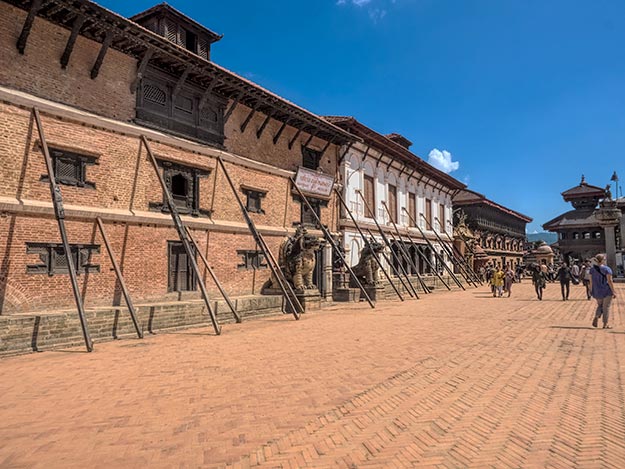
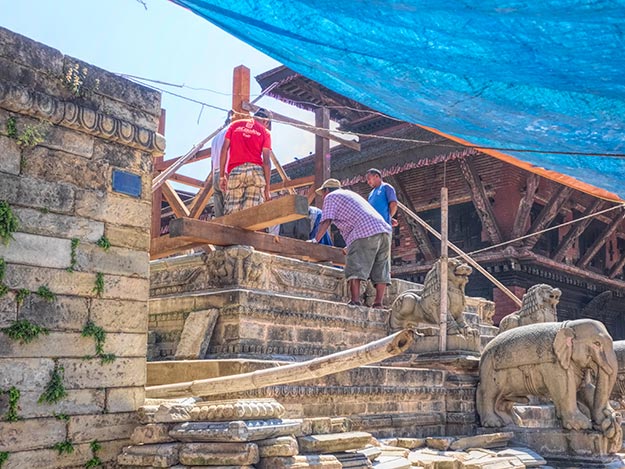
To my surprise and delight, I found restorations well underway at Bhaktapur Durbar Square. But I learned that the process had been anything but smooth. Initially, the Nepal government took charge of the work. Months later, little, if anything, had been accomplished. Disgusted by the indifference and corruption of elected officials, the residents of Bhaktapur took over. The majority of residents in Bhaktapur are Newari, a culture known for its exquisite sculpture and woodworking. The city fathers set about cleaning up the squares, shoring up buildings, and preserving materials that could be reused in the rebuilding process. They hired local bricklayers who had special knowledge about ancient building practices and artisans schooled in the crafting of traditional carved wooden windows and doors. By the time I visited, some of the temples had been completely rebuilt while repairs on others were well underway.

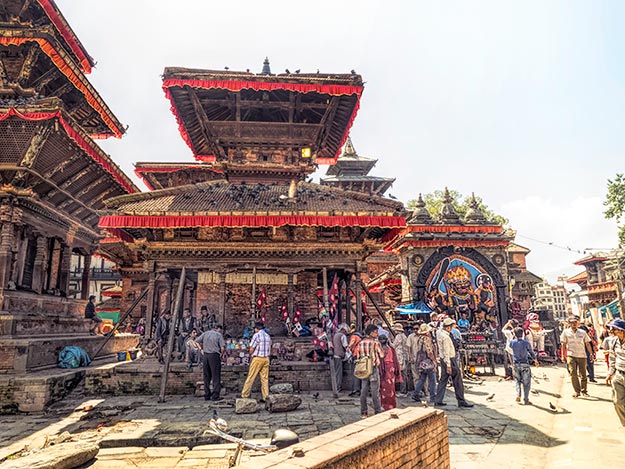
Basantapur Durbar Square in the center of Kathmandu was the most damaged of the three palace squares. Seven temples were completely destroyed and every other structure suffered damage to some extent. Yet while other sites in the valley are making progress, Kathmandu’s Durbar Square is an absolute mess. Irreplaceable wooden beams, carved with ancient tantric scenes, lie scattered around the main plaza. Weeds sprout from mounds of handmade terracotta roof tiles. The capstone of King Malla’s column, which toppled during the earthquake, still lies at the foot of the column, slowly disintegrating.
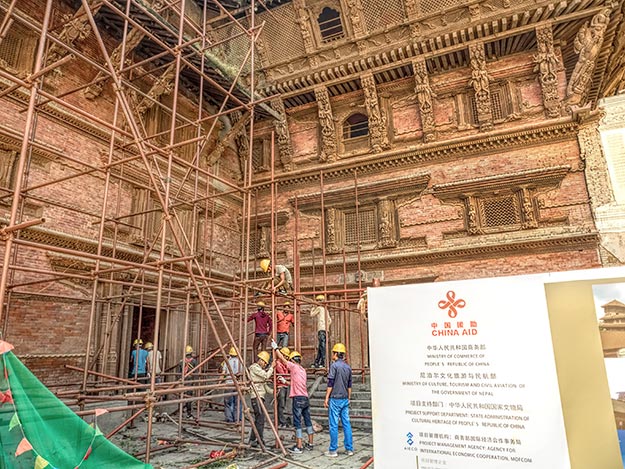
Unfortunately, it doesn’t look like this situation is going to change any time soon. Local and national government bodies fight over who has authority and even when they do agree, they are often stymied by the Department of Archeology. A corrupt bidding system practically insures that any repairs that are accomplished are of poor quality. I have even heard rumors that truckloads of historic carvings and sculptures, many of which would have been repairable and reusable, were hauled out and dumped in landfills. Motorcycles and taxis still weave through the crowds in the main square, which is supposed to be a pedestrian zone. The only bright spot is inside Hanuman Dhoka Palace, where the Chinese government is funding and overseeing the restoration of the beautiful old building.
Adding insult to injury, the entry fee for foreign nationals at Basantapur Durbar Square has been bumped up to 1,000 Nepali Rupees (about $10 USD), under the guise that the funds are necessary for rebuilding. Frankly, I detoured through side streets in order to avoid the ticket booth. I refuse to line the pockets of politicians who are responsible for this disgusting display of corruption and utter incompetence.

I departed Kathmandu with a mix of hope, sadness, and frustration. Frustration that Nepal can’t seem to get its act together. Sadness that some of the beautiful ancient structures were too damaged to ever be rebuilt. But also hope, because Nepalis have demonstrated what can be accomplished when local communities take matters into their own hands.

Hi Barbara,
I appreciate your love and concern towards our Nepal. I hope you can visit Nepal soon to see the changes it has made today. There are still many jobs unfinished with restoration process, it has been a slow progress. Yet, I would imagine you would appreciate how much has been they have accomplished. Its amazing to see how these talents have tried and been able to restore most, if not all, of these invaluable structures. See you in Nepal soon. 🙂
Samir
Hi Samir. Thanks so much for your comment. I try to get to Nepal ever 18 months, at the very least. I love it there.
Wonderful Barbara. I recall you chatting about this during our lunch in Chiang Mai. Beautiful how things are rebuilding slowly but surely.
Ryan
Thanks for your intrest. ..time will come all, we r not bad.
Hi Suresh: I love Nepal and the Nepali people, so I’m sorry if you thought I meant anything bad. In fact, my article said just the opposite. The people are having a positive impact on the temple restorations. It’s just the government, the politics, and the corruption that needs to be reformed.
Hey Barb! Thanks for these beautiful photos. So nice to see the temples coming back to life!
How are you doing? Still loving life on the road?
Hi Laura Lee! So wonderful to hear from you. I’m doing great. After 11 years of travel, nearly eight years with no home base and only a suitcase, I finally decided to put down roots this past December. I’ve rented a year-round apartment in Chiang Mai, Thailand. Love it here. I’ll still be traveling a lot, but it’s so nice to have a place to come home to where I can park my stuff. Hope you are well. Drop me a line via email sometime.
Thank you Barbara for the excellent update on what’s actually been happening with the rebuilding in Nepal & Kathmandu. I, too, am so very sad about the devastation of the earthquake, having last visited Nepal in 2012 and falling in love with the country. Definitely good news about Bhaktapur but not so good about Kathmandu’s Durbar Square. Heartbreaking really!
Hi Janet: Heartbreaking is indeed the best word to describe it. Unfortunately, there is still considerable corruption in Nepal, but things are slowly improving. The Nepali people are demanding change and have become much more intolerant about corruption, which is a very good sign. Fingers crossed that it continues.